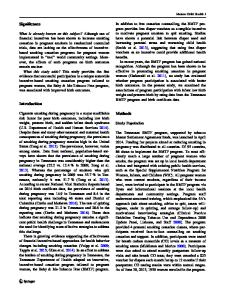Effects of smoking cessation on biological monitoring markers in urine
- PDF / 1,068,935 Bytes
- 9 Pages / 595.276 x 790.866 pts Page_size
- 100 Downloads / 326 Views
RESEARCH
Open Access
Effects of smoking cessation on biological monitoring markers in urine Yuya Kawasaki1, Yun-Shan Li1, Yuko Ootsuyama1, Kazuhiko Nagata2, Hiroshi Yamato3 and Kazuaki Kawai1,4*
Abstract Introduction: Urinary nicotine and cotinine levels are often measured as biomarkers for tobacco smoke exposure. However, these biomarkers are not appropriate to evaluate the effects of quitting smoking for several days, because of their short half-lives. In this study, we focused on the changes in the urinary 4-(methylnitrosamino)-1-(3-pyridyl)1-butanol (NNAL) levels of 55 patients in a smoking cessation program, because of the long half-life. At the same time, urinary 7-methylguanine (m7Gua) and 8-hydroxy-2′-deoxyguanosine (8-OHdG), as DNA damage markers of cigarette smoking, were also measured. Results: In the subjects who completed the quit-smoking program (18 subjects out of 55), the urinary nicotine and cotinine levels decreased to 1.7 and 0.2% at 8 weeks after the first visit to the clinic. By contrast, the NNAL levels decreased to 12.3% at 8 weeks after quitting smoking. During the same period, the urinary m7Gua levels significantly decreased, from 27.32 μg/mg creatinine to 14.17 μg/mg creatinine by the elimination of subjects who showed increased levels of NNAL during the smoking cessation program. The 8-OHdG levels were also reduced within the same period, but were not significantly different. From the all data analysis, the urinary levels of cotinine and NNAL positively correlated with the level of m7Gua. Conclusions: NNAL may be an appropriate exposure marker for evaluating the smoking status of patients in a smoking cessation program. The urinary cotinine and NNAL levels positively correlated with the m7Gua levels. Keywords: Nicotine, Cotinine, 4-(methylnitrosamino)-1-(3-pyridyl)-1-butanol (NNAL), 7-methylguanine (m7Gua), 8hydroxy-2′-deoxyguanosine (8-OHdG), Smoking cessation
Introduction Tobacco smoke contains more than 5000 chemicals and over 70 types of carcinogens [1, 2]. Smoking has been established as a risk factor for many common cancers [3]. The percentage of smokers is decreasing each year in Japan (from 24.2% in 2006 to 17.8% in 2018); however, it still remains high, especially among men (29.0% in men vs. 8.1% in women) [4]. Smoking cessation is one * Correspondence: [email protected] 1 Department of Environmental Oncology, Institute of Industrial Ecological Sciences, University of Occupational and Environmental Health, Japan, 1-1 Iseigaoka, Yahatanishi-ku, Kitakyushu, Fukuoka 807-8555, Japan 4 Center for Stress-related Disease Control and Prevention, University of Occupational and Environmental Health, Japan, 1-1 Iseigaoka, Yahatanishi-ku, Kitakyushu, Fukuoka 807-8555, Japan Full list of author information is available at the end of the article
of the most effective interventions to prevent cancer. At smoking cessation programs in hospitals and clinics, the abstinence status is usually biochemically confirmed by an expiratory carbon monoxide (CO) concentration below 9 ppm. However,
Data Loading...











